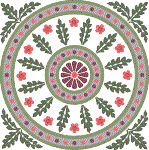 |
Fate
by Mary LambertAnd what is a Mother but thecontainer of everything we are? She is speaking now, my mother of the silent depths intractable. And her mother through her. At last. The distance is shortened. Poisonous to touch in life, it withered any truth and skewed our visions of each other. Now that the scab is off, I can see where your pain was. We connected there and went blind, catalyzing our fate. Our lives paralleled, reflecting the broken places; our journey a swastika of fateful, implicit turns. Slowly, the juices boiled, timed precisely so the prepared mix would birth in me and more equally align our gestalt. Those ideals! Killers. But they got the job done, stirring poison for half a century, the struggle finally transmuting pus into gold. At last, my hardness melts, drop by drop, and in this softer shape, your features do not turn me to stone. We commune and find we are each other. Our bind loosens, pushing the shadow back. There is a golden light near the floor. I hope you catch the glow, thus shining the cord between us giving us that tensile strength so indigenous to women. I am considering this last awareness of your presence: That the bitter cup given you was imputed to me, its genetic map carefully charted with purpose. Does this make your place easier? Can you feel the alignment? Does my increased liberation enhance your field, wherever that may be? Does my small accomplishment create a wave through our women, back to some place in lineage unknown to either of us? It seems it must somehow reflect. If shadow follows us, one generation to the next, cannot light reflect back-- like sun on a mirror? | |
|
Fate (Erinyes): Erinyes is a Greek word for the three faces of fate: Maiden, Fruitful Wife, Old Crone. From Greene, "Astrology and Fate", 1984, 1986 Swastika: An ancient symbol with many meanings, the swastika has been seen as a symbol of the succession of the generations. The hooks on the ends of its arms are the ships of life, or the different stages of life. (It is generally seen to rotate.) From: Cirlot, J.E. A Dictionary of Symbols, 1983. | ||
|
Garden of Grasses Home Page |